Health Care > EXAM > Module 6 Safety and Infection Control (All)
Module 6 Safety and Infection Control
Document Content and Description Below
After discussing the use of restraints with a client and family, a physician has written a prescription for wrist restraints to be applied to a client. The nurse instructs the nursing assistant to app... ly the restraints. Which of the following observations by the nurse indicates that the nursing assistant is using the restraints safely and correctly? Select all that apply. - ANSWER B The restraints are being released every 2 hours. C A safety knot has been used to secure the restraints. E The call light has been placed within reach of the client. Rationale: Restraints should never be applied tightly, because this could impair circulation. They should be tied to the bed frame (not the siderail) with the use of a safety knot. The client could sustain injury if the siderail were lowered with a restraint attached to it. A safety knot is used because it can easily be released in an emergency. Restraints must be released every 2 hours to facilitate inspection of the skin, help ensure good circulation, and permit movement of the joint through its range of motion. The call light must always be within reach of the client in case he or she needs assistance. A triage nurse in an emergency department (ED) is attending to the victims of a train crash. All victims are alert. Which of these clients does the nurse assign to the emergent category? Select all that apply. - ANSWER A A victim with respiratory distress C A victim with partial amputation of the foot Rationale: One rating system commonly used in the ED consists of three tiers — emergent, urgent, and nonurgent — with the categories sometimes identified with color coding or numbers. The emergent classification (a.k.a. red or priority 1) is given to clients with life-threatening injuries (here, the clients with respiratory distress [airway] and partial amputation of the foot [bleeding/circulation]) who require immediate attention and continuous evaluation but have a high chance of survival once their conditions have been stabilized. The urgent (a.k.a. yellow or priority 2) classification is given to clients whose injuries and complications are not life threatening (here, the client with the fractured humerus), provided that they are treated within 1 to 2 hours; such clients require evaluation every 30 to 60 minutes thereafter. The nonurgent (a.k.a. green or priority 3) classification is given to clients with local injuries (here, the clients with the forehead laceration and bruises of the arms and legs) who do not have immediate complications and can wait several hours for medical treatment; these clients require evaluation every 1 to 2 hours thereafter. A nurse is preparing to clean up a blood spill on the client's bedside table that occurred when a blood tube containing a specimen from the client broke. What steps should the nurse take to clean up the blood spill? Select all that apply. - ANSWER A Using tongs to collect any broken glass B Wearing gloves for the cleanup procedure E Disinfecting the area of the blood spill with a dilute bleach solution Rationale: The nurse should blot the spill with an absorbent disposable material such as disposable paper towels or terry wipes, not a face cloth or towel. Tongs are used to pick up any broken glass, and gloves are worn for the procedure. The broken glass is disposed of in a puncture-resistant container. The area is disinfected with a dilute bleach solution or other agency-accepted product. A nurse, preparing a sterile field on which to perform a dressing change, places the sterile drape on the overbed table. Which of these actions on the part of the nurse indicate correct understanding of the principles of aseptic technique? Select all that apply. - ANSWER B Positioning the sterile field so that it remains in full view E Picking up a pair of sterile scissors from the sterile field with a sterile gloved hand F Pouring sterile wound cleansing solution into a sterile cup before donning sterile gloves Rationale: The principles of surgical asepsis must be followed in the preparation of a sterile field. Among these principles: A sterile object remains sterile only when touched by other sterile objects; only sterile objects may be placed on a sterile field; a sterile object or field out of the range of vision or an object held below the nurse's waist is to be considered contaminated; a sterile object or field becomes contaminated with prolonged exposure to air; when a sterile surface comes in contact with a wet, contaminated surface, the sterile object or field becomes contaminated by way of capillary action; fluid flows in the direction of gravity; a 1-inch edge of a sterile field or container is to be considered contaminated. In which of the following situations would the nurse use this type of restraint (mitten restraint)? Select all that apply. - ANSWER D To prevent dislodgment of an intravenous line F To prevent the use of the hands while allowing free arm movement Rationale: A mitten restraint is a thumbless device used to restrain the hands. It prevents the use of the hands while allowing free arm movement. Mitten restraints are useful for the client who must be prevented from dislodging an intravenous line, indwelling urinary catheter, nasogastric tube, other types of tubes, or wound dressings. A belt restraint prevents the client from falling out of a bed, a chair, or a stretcher. A mitten restraint does not secure the shoulders and the waist and is not used to prevent the client from turning side to side. The mother of a 3-year-old calls a neighbor who is a nurse and reports that her child just drank some window cleaner that had been stored in a cabinet. The nurse should instruct the mother to immediately: - ANSWER A Call a poison control center Rationale: When a poisoning occurs, a poison center should be called immediately. Vomiting should not be induced if the victim is unconscious or if the substance ingested was a strong corrosive or petroleum product. Also, vomiting should not be induced unless a healthcare provider has given specific instructions to induce vomiting. Neither calling an ambulance nor calling the physician's answering service is the immediate action, because either would delay treatment. Additionally, the physician would immediately make a referral to the poison control center. The poison control center may advise the mother to bring the child to the emergency department; if this is the case, the mother should then call an ambulance. A home care nurse is visiting an older client who has been recovering from a mild brain attack (stroke) affecting her left side. The client lives alone but receives regular assistance from her daughter and son, who both live within 10 miles. Which of the following actions should the nurse take to assess the client's safety risk? Select all that apply. - ANSWER A Assessing the client's visual acuity B Observing the client's gait and posture C Evaluating the client's muscle strength D Looking for any hazards in the home environment Rationale: To conduct a thorough client assessment, the nurse looks for risk factors related to safety. The assessment should include the assessment of visual acuity, gait and posture, and muscle strength, because alterations in these areas increase the client's risk for falls and injury. The nurse should also assess the home environment, looking for any hazards or obstacles that might affect safety. Asking a family member to move in with the client until recovery is complete and requesting that the client transfer to an assisted living environment for at least 1 month are not assessment activities. Additionally, nothing in the question indicates that these actions are necessary; therefore, these options are unrealistic and unreasonable. A hospitalized client, experiencing confusion, is at risk of falling because she continually tries to climb out of bed. Which of these safety devices that the nurse might suggest is the least restrictive? - ANSWER D Ambularm Rationale: The Ambularm device, worn on the leg, signals when the client's leg is in a dependent position. It is used for clients who climb out of bed and are at risk for falling. Ambularm devices that may be attached to the bed or chair or to the client's mattress or nightgown are also available. A belt restraint is a device that is wrapped around the client's waist to secure the client to bed or to a stretcher. A wrist restraint is a device used to immobilize an arm. An elbow restraint consists of a piece of fabric with slots into which tongue blades are inserted, after which the device is wrapped around the elbow area to immobilize it. Of the options provided, the Ambularm is the least restrictive safety device. A home health nurse has instructed a client about safety measures during the use of an oxygen concentrator in the home. Which statement by the client indicates to the nurse that the client has understood the directions? Select all that apply. - ANSWER A "I need to follow the oxygen prescription exactly." C "I have to keep the oxygen concentrator out of direct sunlight." E "I have to tell everyone that they can't smoke or have an open flame within 10 feet of the oxygen concentrator." Rationale: The client should follow the oxygen prescription exactly. The use of electric razors or other equipment that could emit sparks should be avoided while oxygen is in use, because fire and injury to the client could result. The oxygen concentrator is kept out of direct sunlight and slightly away from walls and corners to permit adequate air flow. The client should not allow smoking or any type of flame within 10 feet of the oxygen source. Other measures include having telephone numbers for the physician, nurse, and oxygen vendor available and teaching the client signs and symptoms requiring emergency care. A nurse educator is providing an inservice program to emergency department nurses about the signs of inhalation anthrax. The nurse educator tells the nurses that one early indication of inhalation anthrax is: - ANSWER C Flulike symptoms Rationale: Inhalation anthrax is caused by the inhalation of spores from Bacillus anthracis, which multiply in the alveoli. This form of anthrax begins with the same symptoms as the flu, including fever, muscle aches, and fatigue. Symptoms suddenly become more severe with the development of breathing problems and shock. Toxins from the anthrax spores cause hemorrhage and destruction of lung tissue. A home health nurse teaches a client about home modifications to reduce the risk of falls. Which statements by the client indicate a need for further teaching? Select all that apply. - ANSWER B "I need to remove my wall-to-wall carpeting." E "I should walk barefoot as much as possible so that I'll know about any wet spots on the floor." Rationale: Home modifications to reduce the risk of falls include ensuring ample lighting, removing scatter rugs, placing handrails in bathrooms, and using handrails on all staircases. The client should wear flat rubber-soled shoes to prevent slips and falls. Walking barefoot will not reduce the risk of injury; in fact, it could actually increase the risk of foot injury and of slipping and falling. Removal of wall-to-wall carpeting is not necessary. Contact precautions are initiated for a client with methicillin-resistant Staphylococcus aureus (MRSA) infection. The nurse, providing instructions to a nursing assistant about caring for the client, tells the assistant: - ANSWER C To wear gloves and a gown when changing the client's bed linen. Rationale: Contact precautions require the use of gloves, gown, and goggles if direct client contact is anticipated. Goggles are worn to protect the mucous membranes of the eye during interventions that may produce splashes of blood or body fluids, secretions, or excretions. The client should be placed in a private room or, if a private room is not available, in a semiprivate room with another client who has active infection with the same microorganism but no other infection. The nursing assistant would remove the protective gear before leaving the client's room. A military nurse who is in charge of planning a vaccination clinic to administer the smallpox vaccine to military personnel is preparing a pamphlet that sets forth guidelines for care of the vaccination site. Which guideline should the nurse include in the pamphlet? - ANSWER D Avoid sharing towels or other items that have come in contact with the vaccination site. Rationale: A scab will form in the spot where the vaccination was administered. This scab should be left alone so that the vaccinia virus in the vaccine doesn't spread to other parts of the body. The site is loosely covered with a gauze bandage; this bandage, in turn, is covered with a waterproof bandage during bathing. Clothing is worn over the vaccination site as an extra precaution. The hands must be washed frequently, including whenever the site is touched or the bandage is changed; the vaccinee should not touch the eyes or any other part of the body after changing the bandage or touching the vaccination site. The vaccinee must avoid scratching or putting ointment on the vaccination site. The vaccinee is told to avoid sharing towels and to launder items that have touched the vaccination site because of the risk of spread of the vaccina virus. A nurse is preparing a disaster preparedness checklist, identifying emergency plans and supplies that will be needed in the event of a disaster, for a community group. Which instructions should be included on the list? Select all that apply. - ANSWER A Have a first aid kit available. C Plan a meeting place for family members. E Have an adequate supply of prescription medications. F Have a battery-operated radio and a flashlight and batteries available. Rationale: Personal preparedness for a disaster includes planning a meeting place for family members, identifying safe spots in the home for each type of disaster; having a 3-day supply of water (1 gallon per person per day) and a 3-day supply of nonperishable food; and having clothing and blankets, a first aid kit, a battery-operated radio, a flashlight, and batteries available. For safety reasons, the nurse would not recommend that a weapon be kept. A nurse enters the laundry room to empty a bag of dirty linen and discovers a fire in a laundry basket. What action should the nurse take first? - ANSWER C Activating the fire alarm Rationale: The immediate priority in the event of a fire is rescuing the clients in immediate danger. In this situation, no clients are in immediate danger. The next step is to activate the fire alarm. The nurse then confines the fire by closing all doors and, finally, extinguishes the fire. Which of the following events would require a nurse to complete and file an incident report? - ANSWER D When a visitor suddenly becomes weak and dizzy, the nurse checks the visitor's blood pressure and takes the visitor to the emergency department for treatment. Rationale: An incident is any event that is not consistent with the routine operation of a healthcare unit or routine care of a client. Examples of incidents include client falls, needlestick injuries, a visitor having symptoms of illness, medication administration errors, accidental omission of prescribed therapies, and circumstances leading to injury or a risk for injury. An incident report does not need to be filed if a client has a seizure unless the client sustains injury as a result of the seizure. If the nurse determines that a client would benefit from the use of a walker to ambulate, he or she should take the appropriate action to obtain one. If the nurse notes that the battery of an intravenous infusion pump is not working, he or she should obtain a functioning pump and send the nonfunctioning pump to the appropriate department for repair. A nurse preparing to perform a sterile dressing change notes that the covering of a package of sterile 4 × 4 gauze pads has a small tear. Which action should the nurse take? - ANSWER A Discarding the package Rationale: When performing a surgically aseptic procedure, the nurse must follow certain principles of aseptic technique to ensure maintenance of asepsis. A sterile object remains sterile only when touched by other sterile objects. If the sterile state of an object is questionable (e.g., if there is a tear or break in the covering of a sterile object), the nurse must discard the object, because it is considered contaminated. Therefore the nurse in this situation would not use the gauze pads. A nurse, charting the administration of medications to an assigned client at 9 pm, notes that atenolol (Tenormin) was prescribed to be administered at 9 am instead of 9 pm. The nurse checks the client's vital signs, completes an incident report, and calls the physician to report the error. The physician tells the nurse that an incident report is not needed but instructs her to monitor the client during the night for hypotension. What action should the nurse take? - ANSWER C Telling the physician that the error warrants the completion of an incident report Rationale: Incident reports are an important part of a healthcare agency's quality improvement program. An incident is any event that is not consistent with the routine operation of a healthcare unit or routine care of a client. An example of an incident is administering a medication at a time at which it is not prescribed to be given. Whenever an incident occurs, an incident report is completed and filed in accordance with agency guidelines. The nursing supervisor would be notified of the incident; however, on the basis of the data in the question, the nurse should tell the physician that the error warrants completion and follow-through with an incident report. Therefore, the other options are incorrect. The safety department is providing a yearly educational session on fire safety and the use of fire extinguishers. A nurse is asked to demonstrate the use of a fire extinguisher after the session. The nurse demonstrates appropriate use of the fire extinguisher by first: - ANSWER B Pulling the pin on the fire extinguisher Rationale: To use a fire extinguisher, pull the pin first. Next, aim the extinguisher at the base of the fire. Squeeze the handle of the extinguisher, then extinguish the fire by sweeping from side to side to coat the area evenly. An older client in a long-term care facility is at risk for injury because of confusion. Which of the following devices would be the best choice to help prevent injury while the client is in bed? - ANSWER If the client is confused, the least intrusive method of restraint is the use of a bed alarm such as the Bed-Check bed exit alarm device. It consists of a weight-sensitive mat, placed on the client's mattress, that sounds an alarm when the sensor detects the removal of pressure. A belt restraint secures the client to the bed or stretcher. It restrains the center of gravity and prevents the client from sitting up on or rolling off a stretcher or falling out of bed. The extremity (ankle or wrist) restraint is used to immobilize an extremity as a means of protecting the client from injury resulting from a fall or the accidental removal of a therapeutic device such as a Foley catheter. The mitten restraint is a thumbless mitten device that is used to restrain the client's hand. It prevents the client from dislodging invasive equipment, removing dressings, or scratching him- or herself. The nurse plans to wear this protective mask (standard mask) when caring for clients with certain disorders. What are these disorders? Select all that apply. - ANSWER D Pharyngeal diphtheria E Streptococcal pharyngitis F Meningococcal pneumonia Rationale: A standard mask is used as part of droplet precautions to protect the nurse from acquiring the client's infection. Droplet precautions are those precautions used to help prevent the spread of organisms that can spread through the air but are unable to remain in the air farther than 3 feet from the source. Many respiratory viral infections require the use of a standard mask during client care. Some of the disorders requiring the use of a standard mask are pharyngeal diphtheria; rubella; streptococcal pharyngitis; pertussis; mumps; pneumonia, including meningococcal pneumonia; and pneumonic plague. Scabies and hepatitis A, transmitted by way of direct contact with an infected person, require the use of contact precautions for protection. Tuberculosis requires airborne precautions and the use of an individually fitted particulate filter mask. A standard mask would not protect the nurse from Mycobacterium tuberculosis. A home care nurse is instructing a client in the use of ice packs to treat an eye injury. The nurse instructs the client to: - ANSWER D Wrap a plastic bag filled with ice in a pillowcase and place it on the eye Rationale: An ice pack placed directly against the skin or left in place for an extended period carries a risk of tissue damage similar to that of a hot water bottle. To help prevent tissue damage resulting from excessive cold exposure, the ice pack should be removed in most cases after 30 minutes; after a short time it may be reapplied. An ice pack should never be placed directly against the skin; instead, it should be covered with a pillowcase or towel. Commercially prepared ice bags are appropriate for use as ice packs. Place in order of priority the actions that the nurse should take to perform hand-washing procedure. - ANSWER The correct order is: A Wet the hands and wrists, keeping the hands lower than the elbows. B Obtain 3 to 5 mL of soap from the dispenser. C Wash all surfaces for 15 to 30 seconds. D Rinse the hands and wrists. E Dry the hands. F Turn off the water faucet. Rationale: Proper handwashing procedure involves wetting the hands and wrists and keeping the hands lower than the forearms so that water flows toward the fingertips. The nurse uses 3 to 5 mL of soap and washes all surfaces for 15 to 30 seconds, using a rubbing circular motion. Moving from the fingers to the forearms, the nurse next rinses and then dries the hands. The paper towel is then discarded and a second one is used to turn off the faucet to help prevent hand contamination. A nurse, assessing a client's readiness for discharge, is performing a home safety assessment to determine whether there are any environmental hazards in the home. Which of the following statements, if made by the client, would prompt the nurse to investigate further? Select all that apply. - ANSWER B "I don't have any nightlights in the house." E "I haven't changed the batteries in the smoke detectors in my home for quite a few years now." Rationale: If the client tells the nurse that there are no nightlights in the home, the nurse should further investigate the situation. Nightlights help prevent falls by the client who may need to get up during the night. The batteries in smoke detectors should be changed at least once a year, so the nurse must investigate further if the client indicates that this has not been done for "quite a few years." The other statements by the client do not reflect environmental hazards in the home. A hurricane is forecast to make landfall in 48 hours, and the staff of the emergency department of an area hospital is advised to prepare for causalities. Which action should the nurse manager who receives the telephone call regarding this warning take first? - ANSWER A Activating the agency disaster plan Rationale: In an external disaster, many people may be brought to the emergency department for treatment. Although increasing the nursing staff and supplying the triage rooms with additional equipment may be steps in preparing for casualties, the initial action by the nurse manager must be activation of the disaster plan. Calling the hospital maintenance department to secure the building from the storm is not a responsibility that falls within the scope of nursing management. A nurse hears someone calling, "Help! My bed is on fire!" On entering the room, the nurse finds a client trying to beat out the flames with a pillow. Place in order of priority the actions that the nurse should take: - ANSWER The correct order is: A Removing the client from the room B Pulling the nearest fire alarm C Closing the door to the room D Running to get the nearest fire extinguisher Rationale: A nurse who encounters a fire emergency should think of the mnemonic RACE. The first step is to remove the client from the room, after which the nurse should activate the fire alarm, contain the fire, and extinguish the fire. This is a universal standard that may be applied to any type of fire emergency. Removing the client from the room is the first step. Pulling the nearest fire alarm is the second step (alarm). Closing the door to the room to contain the fire is the third action. Obtaining the nearest fire extinguisher to put out the fire is the fourth action. A nurse is preparing a continuous intravenous (IV) infusion at the medication cart. As the nurse goes to attach the IV tubing port to the solution bag, the tubing drops, hitting the top of the medication cart. Which action should the nurse take to maintain asepsis? - ANSWER A Obtaining new IV tubing Rationale: If IV tubing becomes contaminated as a result of coming into contact with some nonsterile object, the nurse should obtain new IV tubing. Contaminated tubing could cause systemic infection in the client. The IV solution bag has not been contaminated and does not need replacement. Wiping the tubing port with Betadine or scrubbing it with alcohol is insufficient and would be contraindicated regardless, because the tubing will be attached directly to a catheter in the client's vein. The nursing staff in an emergency department is reviewing and updating the disaster preparedness plan. The staff members, discussing ways to help prevent the transmission of smallpox, know that this infection is transmitted by which route? - ANSWER B Inhalation Rationale: Smallpox, transmitted in air droplets and in the handling of contaminated materials, is highly contagious. Symptoms include fever, back pain, vomiting, malaise, and headache, followed 2 days later by the appearance of papules that progress to pustular vesicles, which are initially abundant on the face and extremities. Enteric, gastrointestinal, and open wounds are not routes of smallpox transmission. A community health nurse is providing an educational session on childhood poisoning at a local school. The nurse tells the group that when an accidental poisoning occurs the first action is to: - ANSWER C Call the poison control center Rationale: When a poisoning occurs, a poison control center should be contacted immediately and any directions given regarding treatment followed. The poison control center will provide directions regarding the inducement of vomiting. However, vomiting should not be induced if the victim is unconscious or if the substance ingested is a strong corrosive or petroleum product. The poison control center may advise the mother to bring the child to the ED; if this is the case, the mother should call an ambulance. Neither bringing the child to the ED nor calling an ambulance would be the immediate actions, because either tactic would delay treatment. A client with a new diagnosis of tuberculosis (TB) is being admitted to the hospital. During the collection of data from the client, which of the following considerations is especially important? - ANSWER B The names of close friends and family members Rationale: TB is a contagious disease that is spread in respiratory droplets. The nurse needs to elicit the names of close friends and family members so that these individuals may be tested for exposure to TB. The client's religious affiliation or church of preference is a component of the data collection process but is not the primary consideration of the options provided. It is premature to determine knowledge regarding medications, because treatment measures may not yet have been prescribed. The client may not know the name of the person from whom the disease was contracted. Which of the following actions are in keeping with the principles of standard precautions? Select all that apply. - ANSWER A Handwashing between client contacts C Discarding needles in puncture-resistant containers E Wearing a face shield as a part of the protective garb during a wound irrigation F Wearing a gown and gloves when changing the linens on the bed of a client with a draining lesion of the leg Rationale: Standard precautions must be practiced with all clients in every setting. These precautions involve handwashing and the use of gloves, masks, eye protection, and gowns, as well as other protective devices, when they are appropriate for client contact. These precautions apply to contact with blood, body fluids, nonintact skin, and mucous membranes. The hands are always washed between client contacts and after (not before) gloves are removed. Needles are not recapped (unless the agency provides special and agency-approved recapping devices for healthcare providers) and are discarded in puncture-resistant containers. Spills of blood or body fluids are cleaned up with a solution of bleach and water (diluted 1:10) or other agency-approved disinfectant. A mask, eye protection, or face shield is worn if client care activities have the potential to result in splashes or spraying of blood or body fluid. A gown is worn if soiling of clothing is likely. The nurse administers a dose of ramipril (Altace) 2.5 mg to a client at 9 am. While documenting administration of the medication, the nurse discovers that 1.25 mg, not 2.5 mg, was the prescribed dose. The nurse assesses the client, completes an incident report, and notifies the physician and nursing supervisor of the error. What statement does the nurse add to the client's record? - ANSWER B Ramipril (Altace) 2.5 mg was administered at 9 am. Rationale: After an incident, the nurse would document a concise and objective description of what occurred and any follow-up actions taken in the client's record. The nurse would not document in the client's record that an incident report was completed. Nor would the nurse document that twice the prescribed dose was given or that an incorrect dose was given. A client with paraplegia has spasticity of the leg muscles. Which interventions should be included in the plan of care for this client? Select all that apply. - ANSWER B Range-of-motion exercises of the affected limbs C An as-needed prescription for a muscle relaxant D Removal of potentially harmful objects near the client E The use of padding against the client's legs when the client is sitting in a wheelchair [Show More]
Last updated: 2 years ago
Preview 1 out of 28 pages

Buy this document to get the full access instantly
Instant Download Access after purchase
Buy NowInstant download
We Accept:

Reviews( 0 )
$10.00
Can't find what you want? Try our AI powered Search
Document information
Connected school, study & course
About the document
Uploaded On
Aug 21, 2022
Number of pages
28
Written in
Additional information
This document has been written for:
Uploaded
Aug 21, 2022
Downloads
0
Views
59

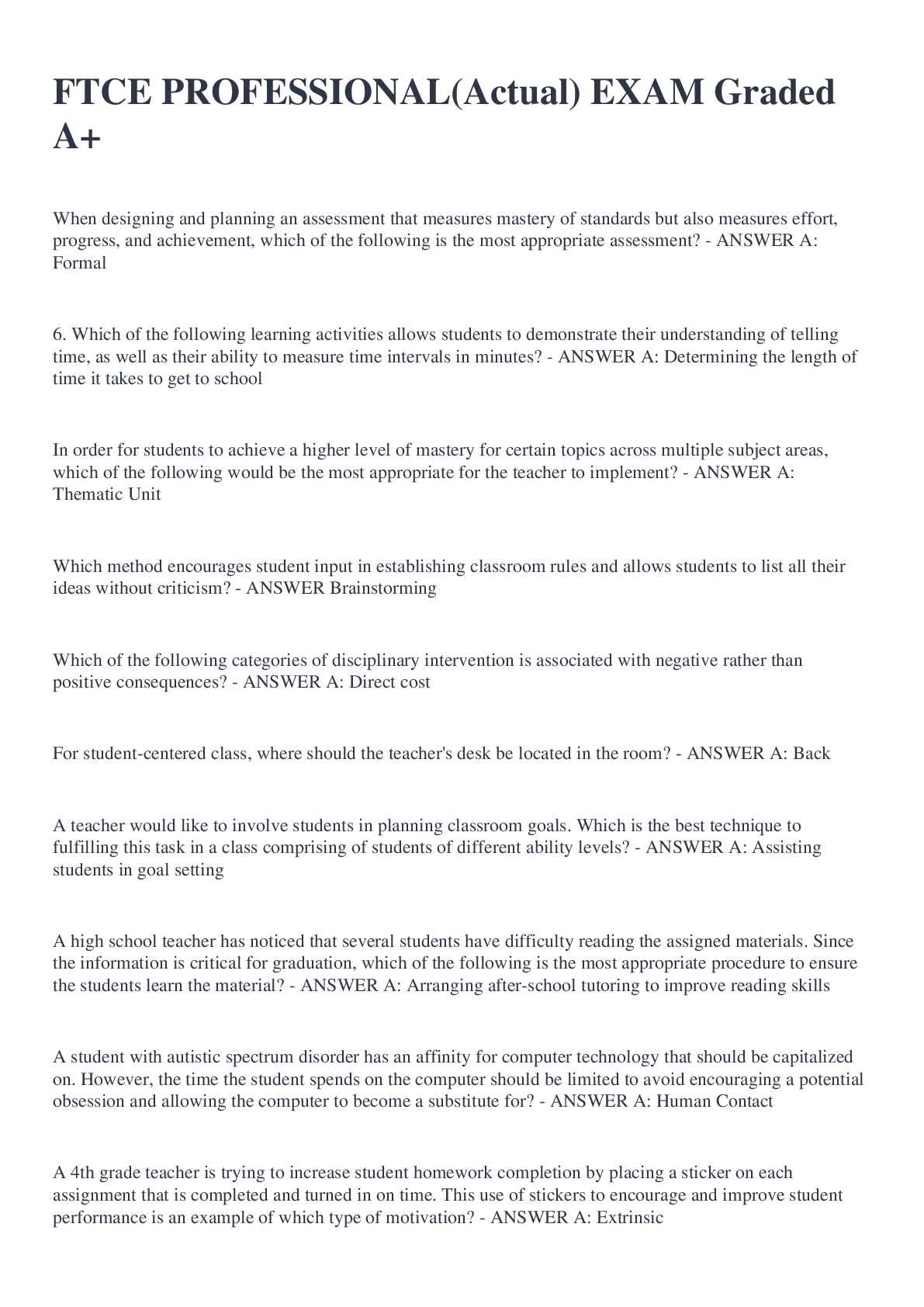
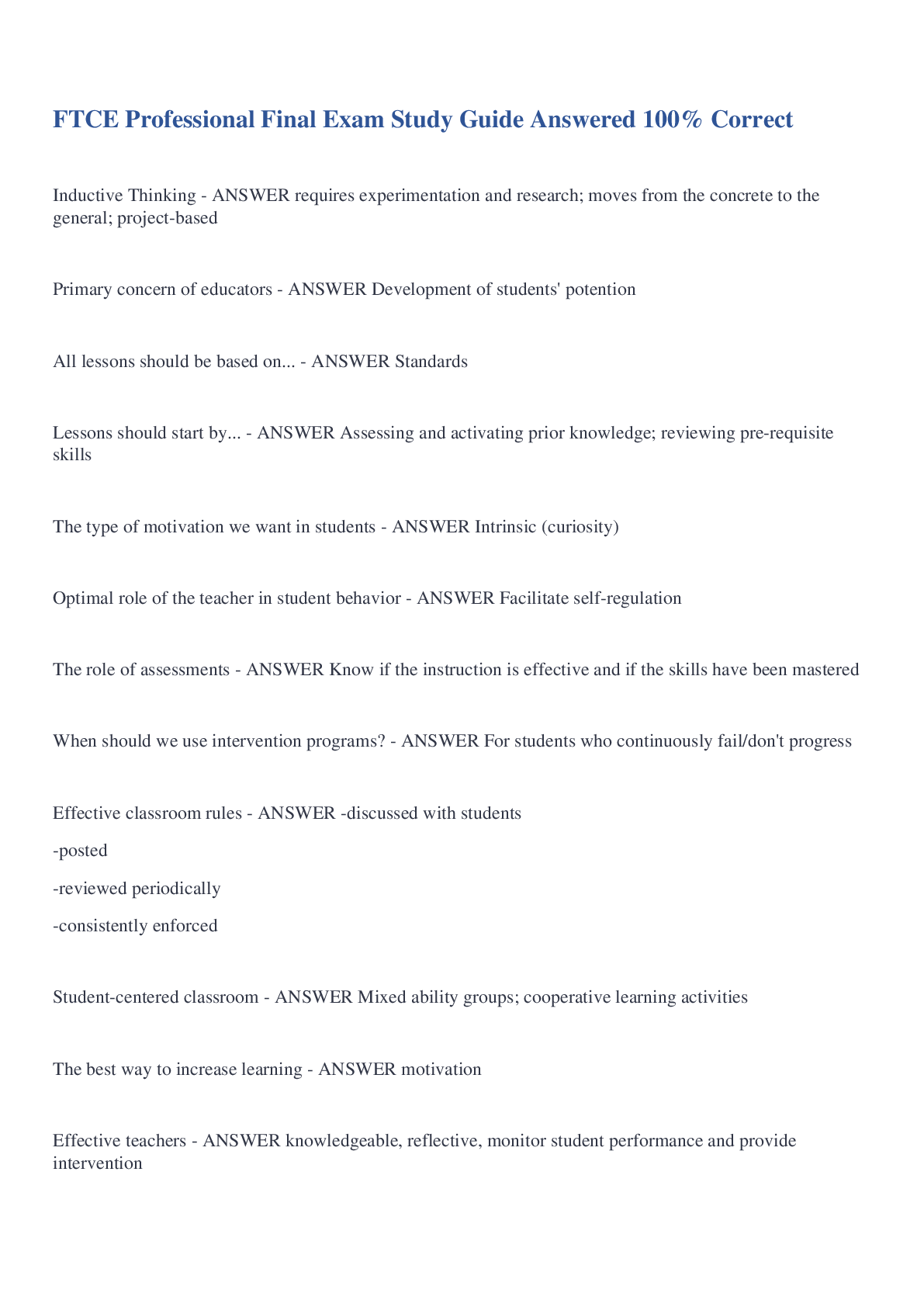
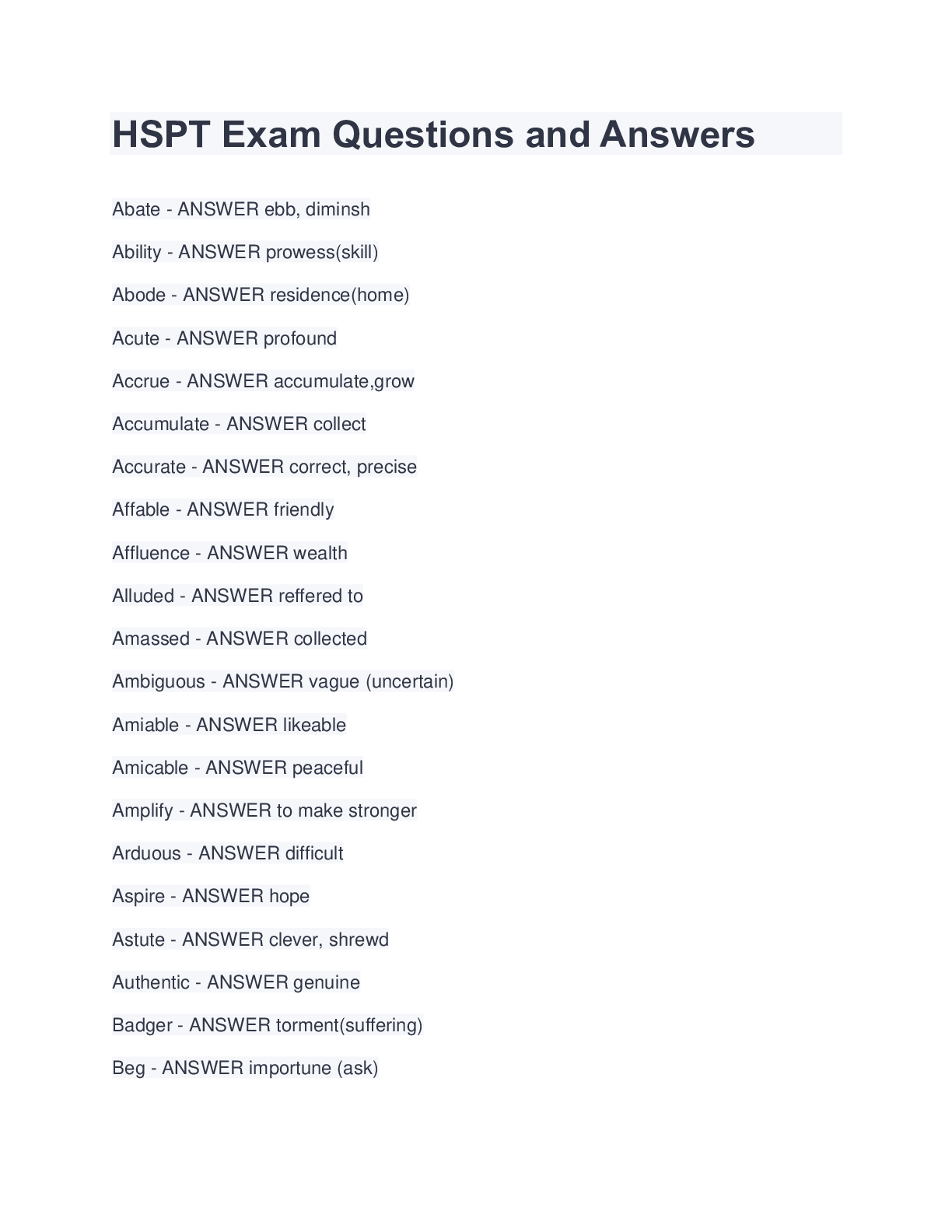
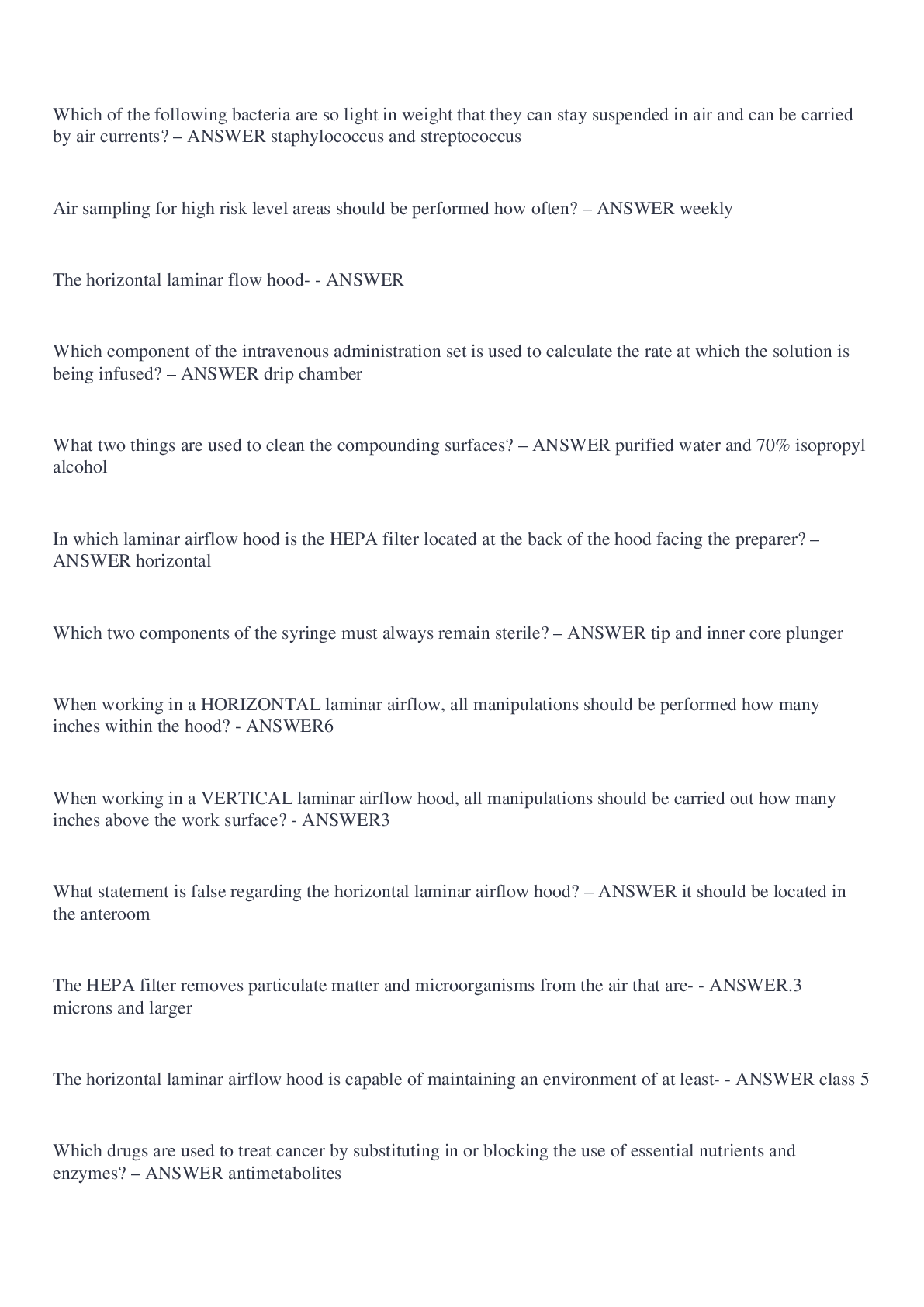
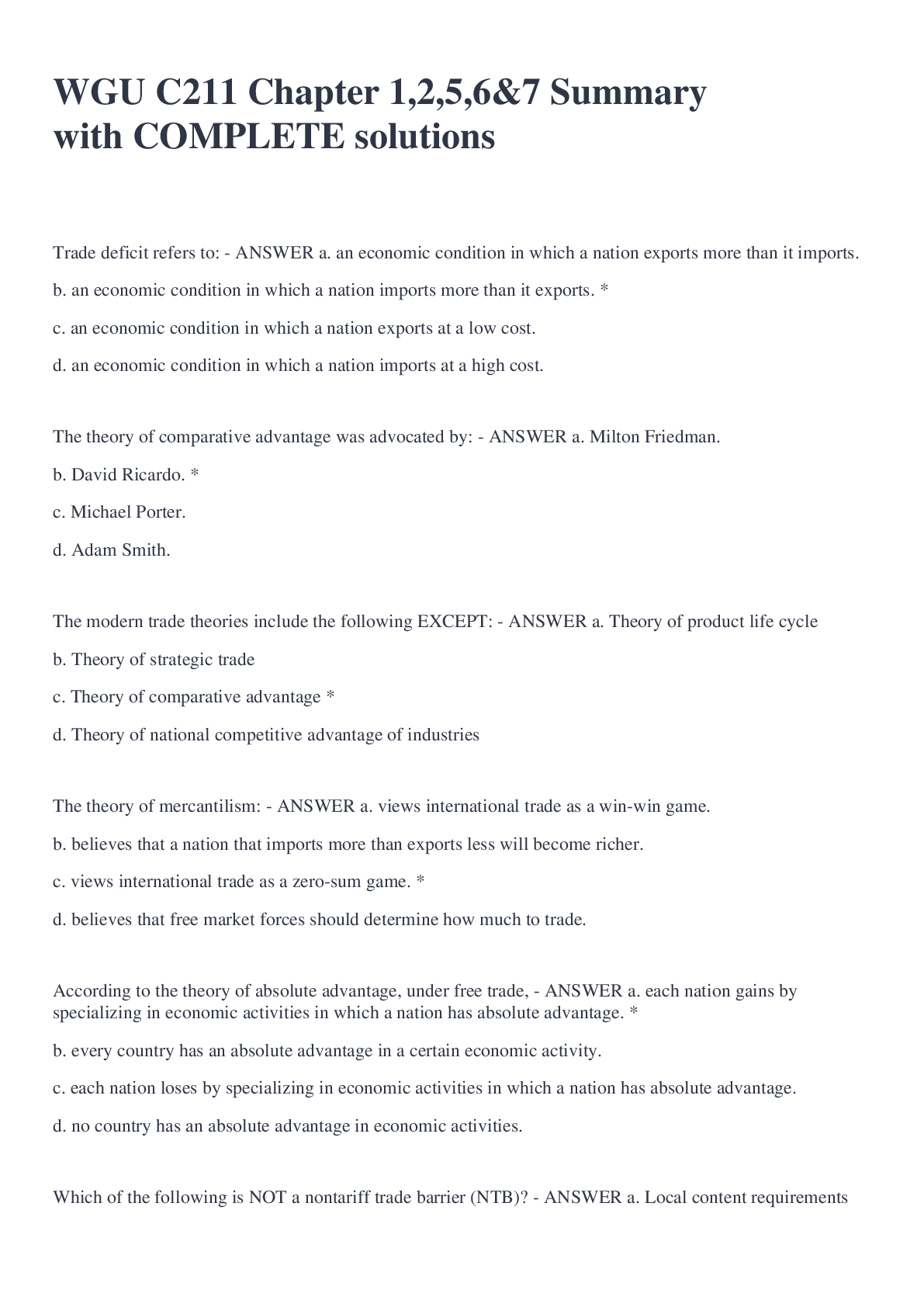
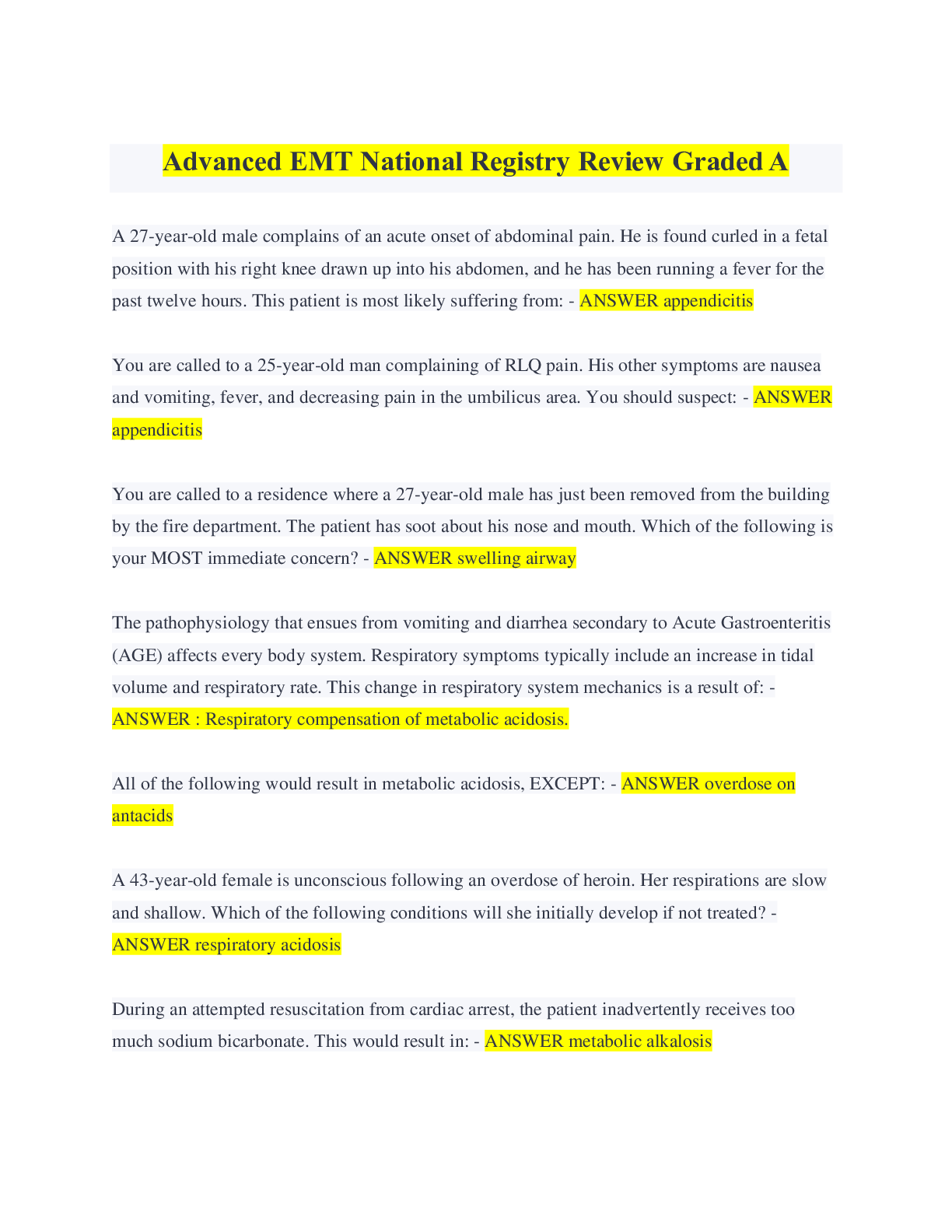
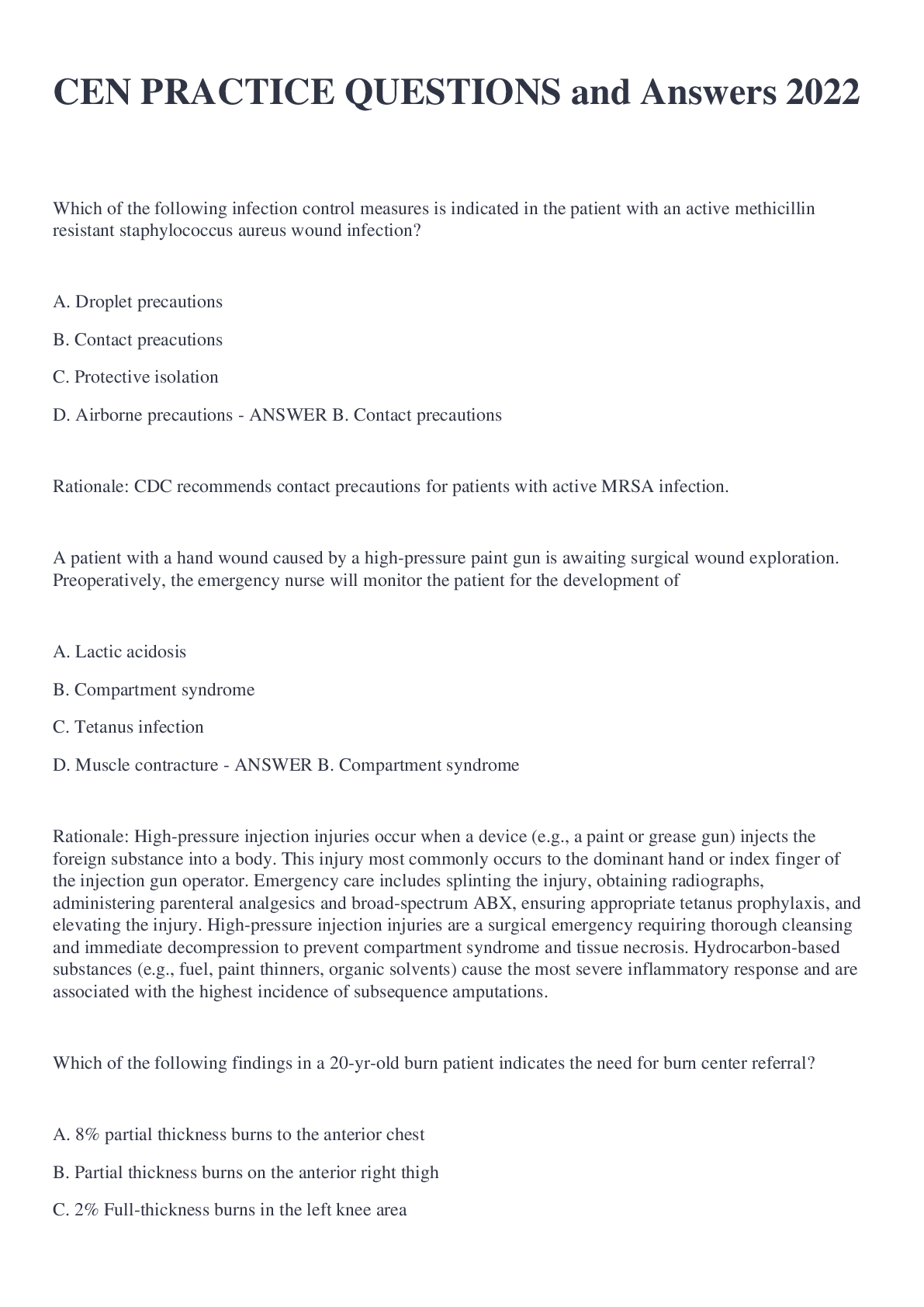
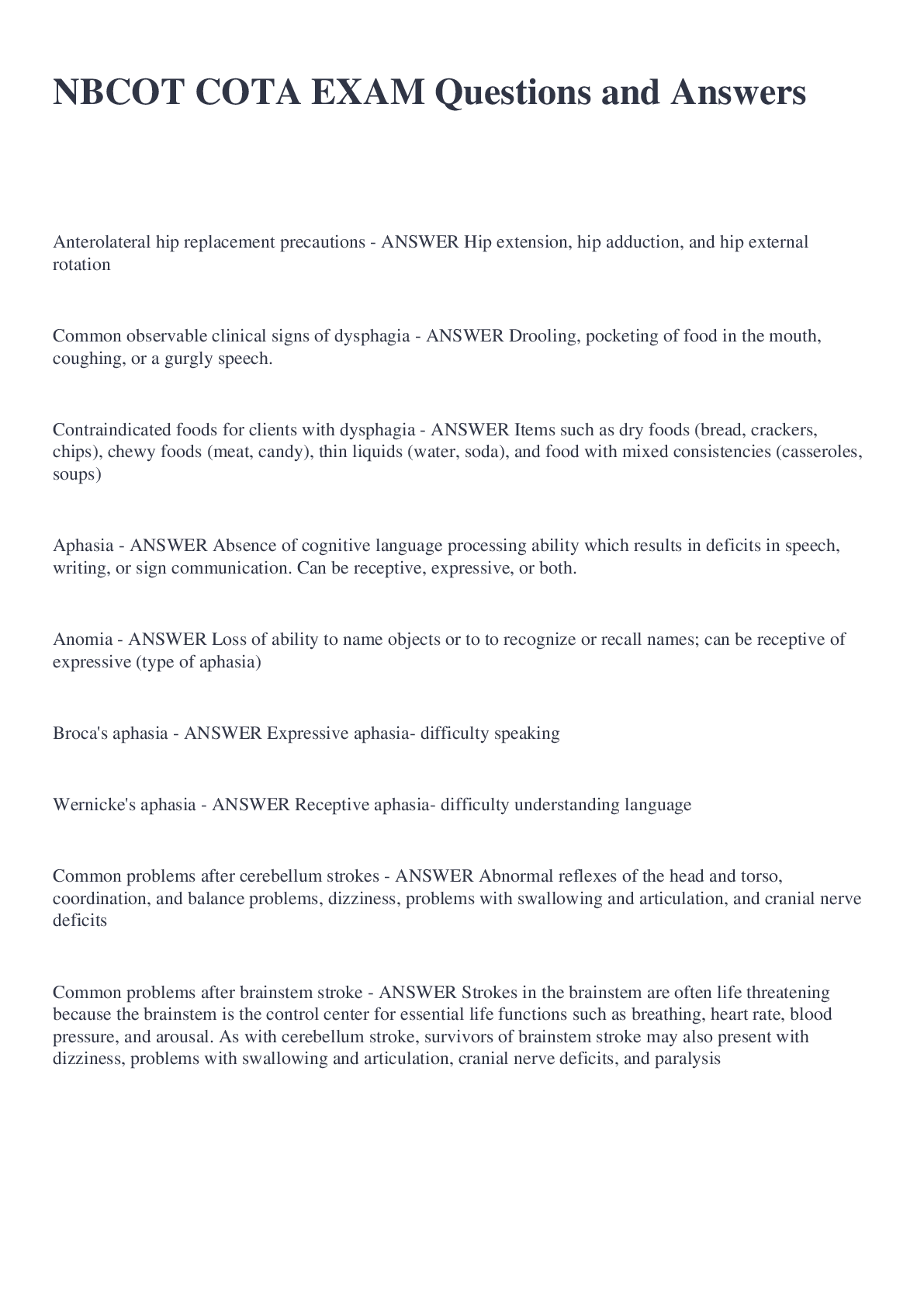
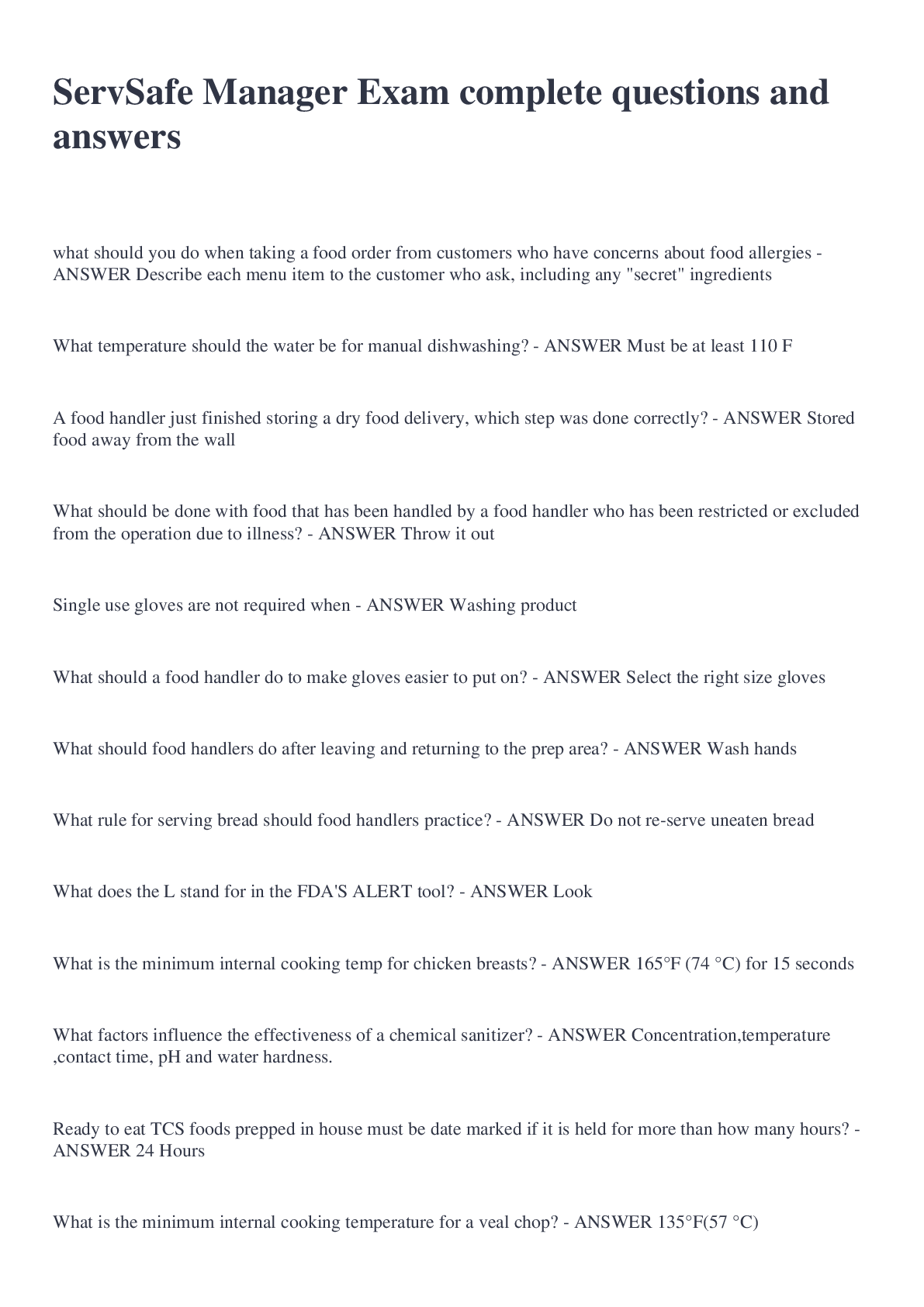
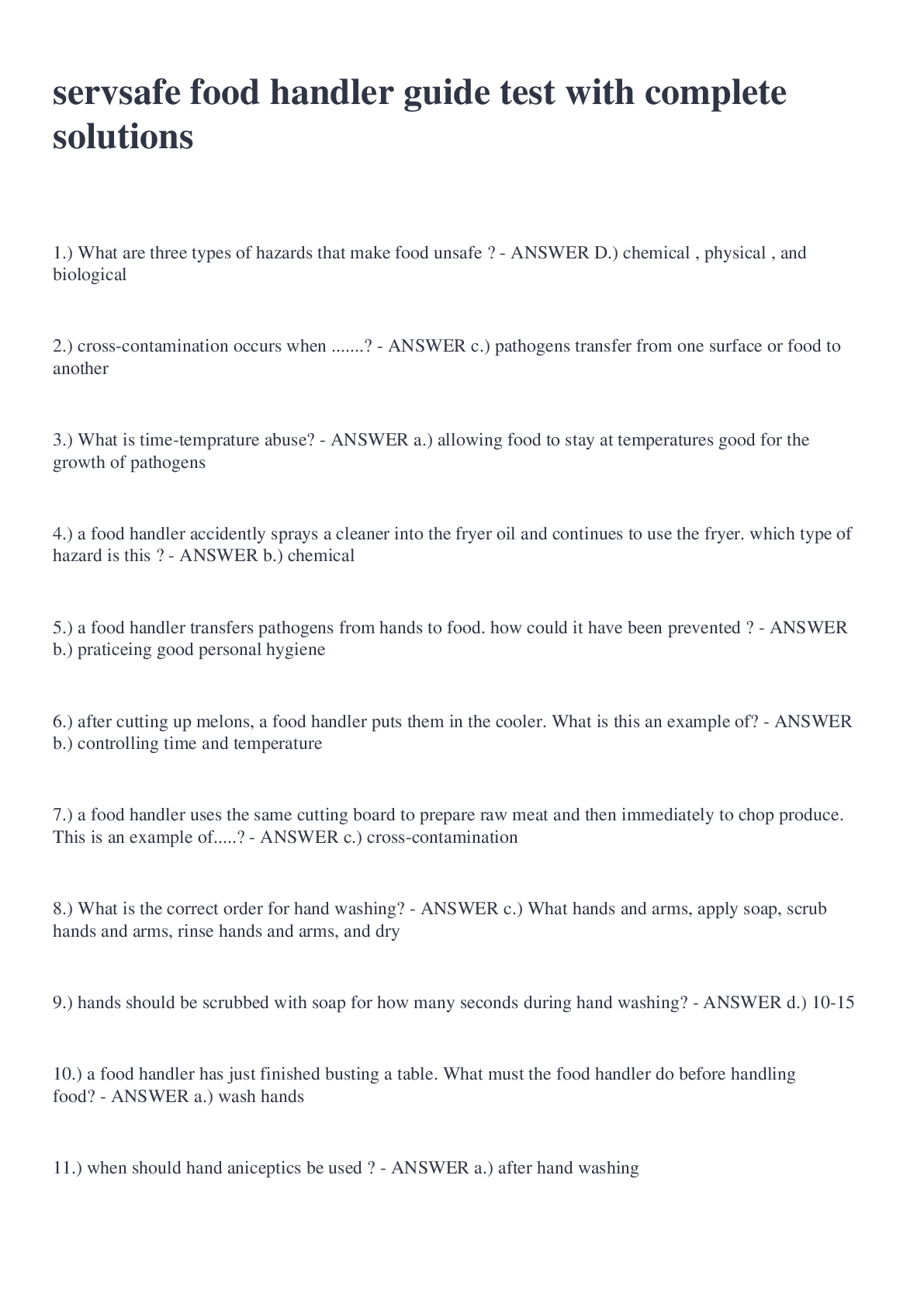
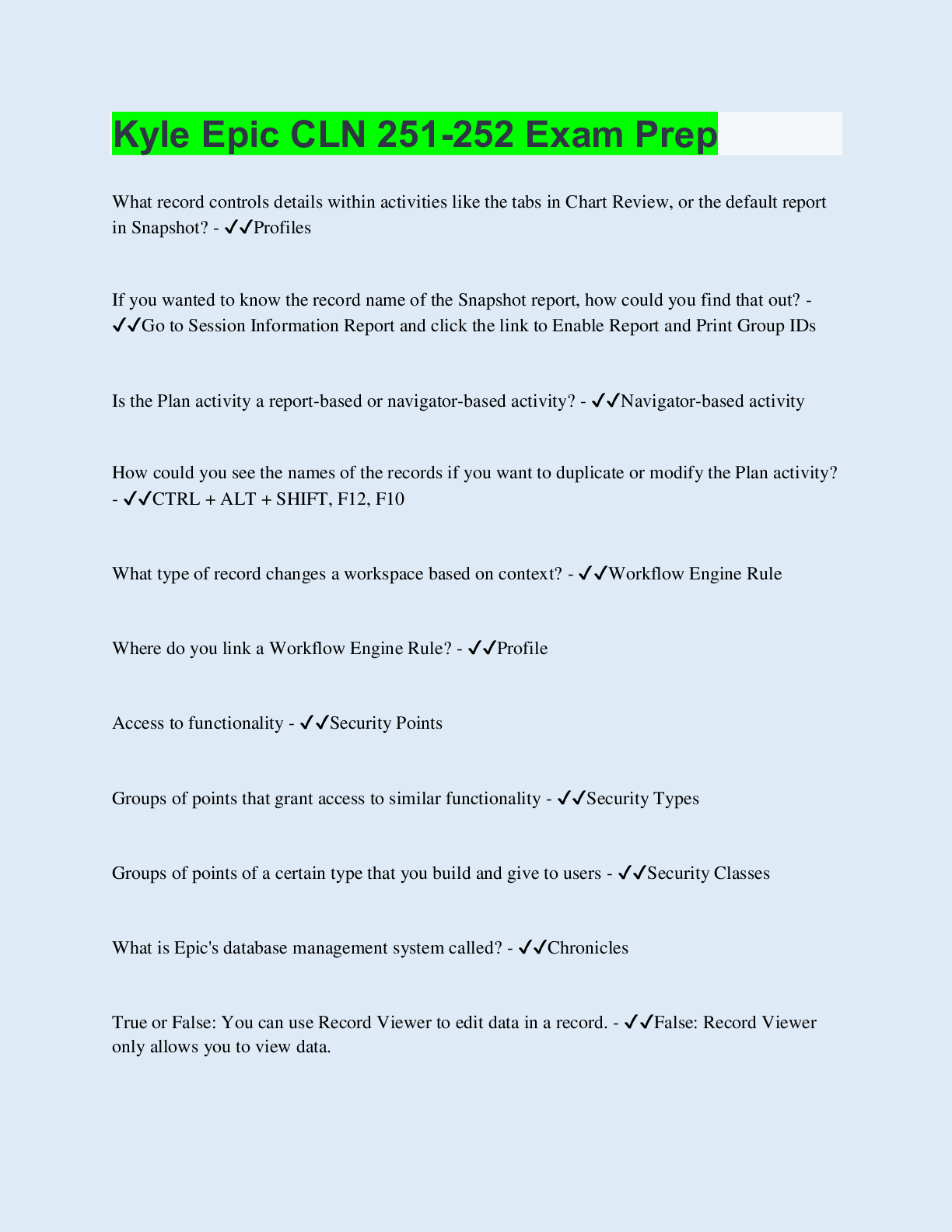
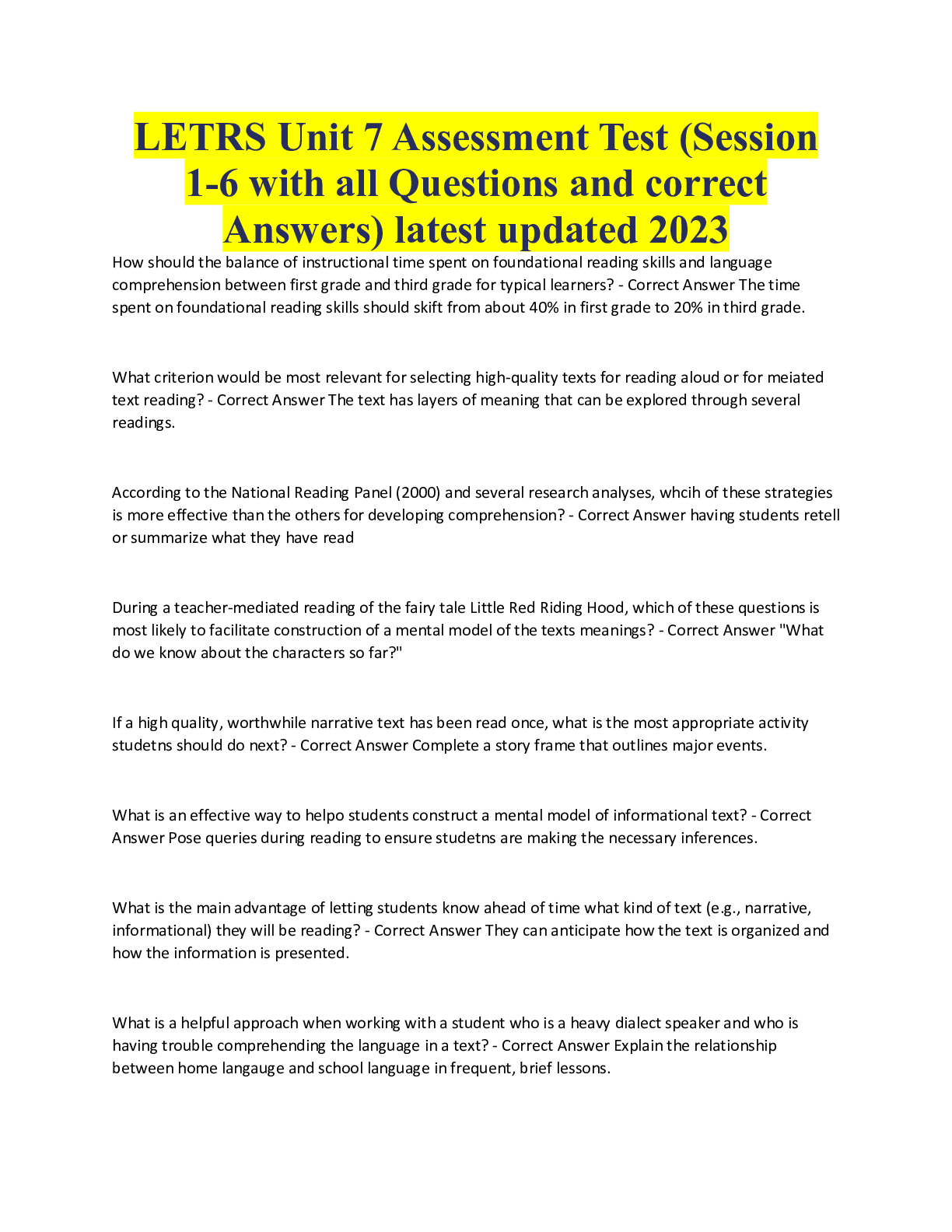
.png)




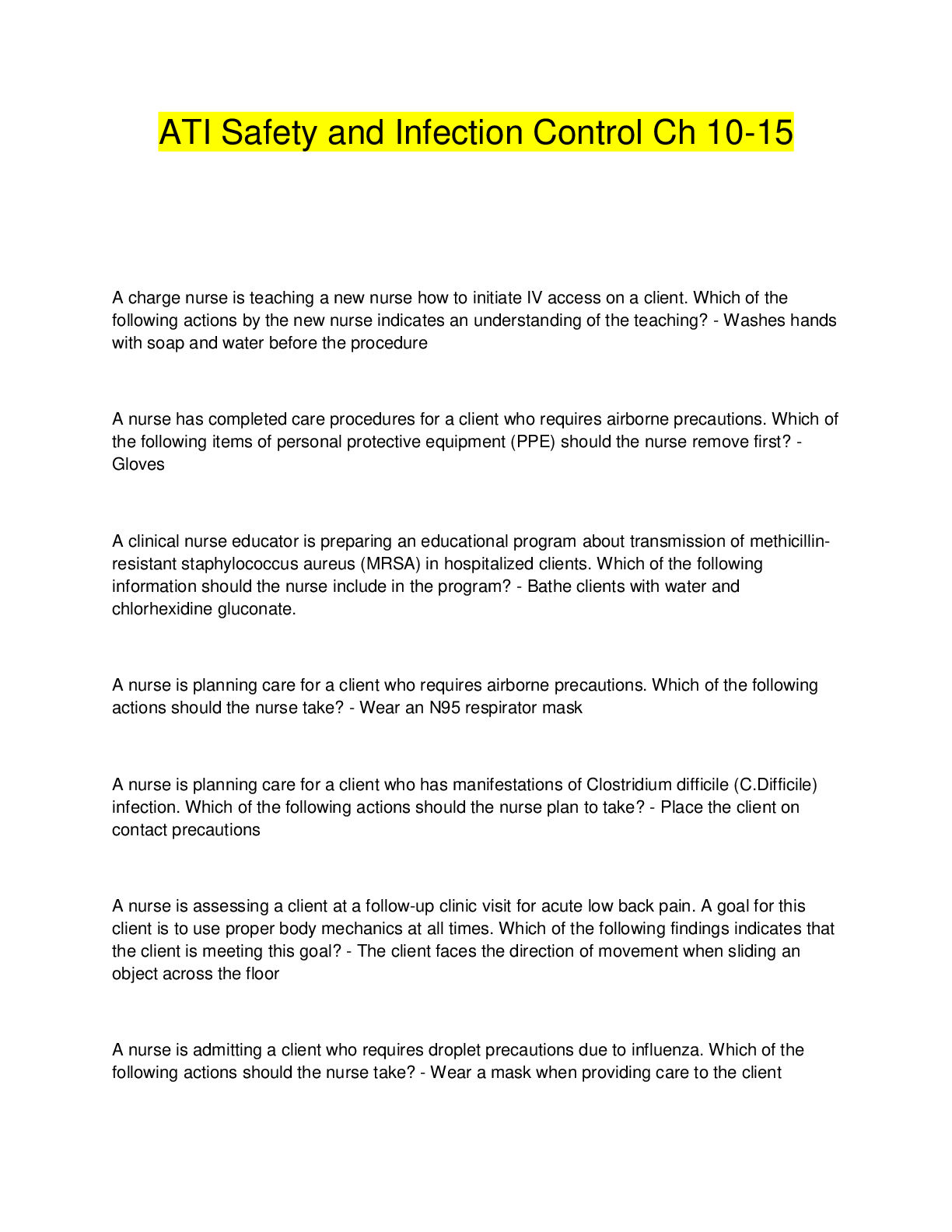

.png)

